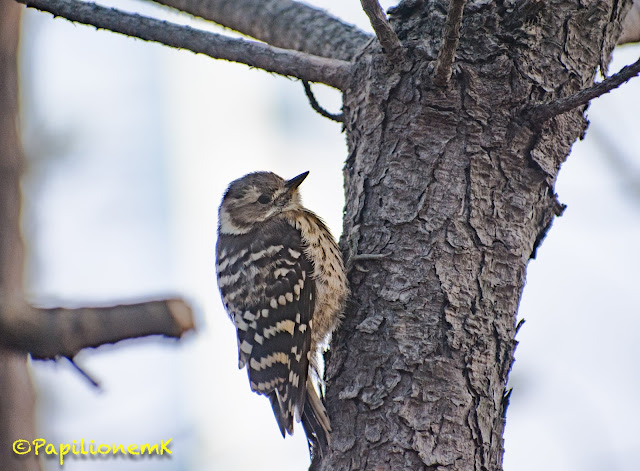Japanese Pygmy Woodpecker, a small, most abundant woodpecker in Japan
As its common name in English (Japanese Pygmy Woodpecker) points out it is found in Japan, it is also distributed in South and North Korea, SE Siberia, and E China.
Those in the photos below were spotted in South Korea.
 |
| A good thing about getting up early and visiting a nearby forest is that there is a high chance of encountering birds. |
It is a small woodpecker with body length ranging from 13-15 cm.
When I first saw them, I speculated they might use cavity nests prepared by their bigger cousines like Great-spotted Woodpecker.
How could such a tiny beak dig out hard skin of a tree?
But I shouldn't have underestimated their power and determination.
They do excavate trees with their tiny beaks like their bigger cousines do.
Yes, that's why they are referred as woodpeckers!
And probably stealing other woodpecker's nest may not be that easy for this tiny bird, so it's better to work by themseleves.
As they are smaller than the larger species of woodpeckers, they are classified as weak excavators.
They prefer dead trees or dead branches of a living tree.
Both strong and weak excavators prefer trees with large diameters, which give more stable support.
According to one research in Japan, an alder tree Alnus hirsuta was the most preferred tree species.
Japanese Pygmy Woodpecker's nests are relatively small but they suit their needs.
The entrance diameter is approximately 3 cm and the deapth of a hole is about 15 cm.
👉 Professor Ken Ishida's article about Japanese Pygmy Woodpecker
They excavate a new hole each year, males do most of the work.
When the nest is prepared, a female lays eggs (mostly 3, range 2 to 5) and the incubation starts when the last egg is laid.
The incubation period and nestling period are 14 and 20 days, respectively.
Both sexes are involved in incubation and nestling but males do more frequently.
Japanese Pygmy Woodpeckers stay together and communicate with their calling.
Although their modest drumming (10 soft beatings per 0.4 seconds) is relatively weak, of which sound cannot travel a long distance, their Kik-kik calling can be efficiently delivered to their mates or family members (and to me as well 😊).
As a primary cavity nesters, they contribute to the ecosystem as Supporting Service providers, which means their contructions are used by other creatures.
What a wonderful creature!
It would be a thrilling moment if I could observe its nest building process with my bear eyes.
I hope I would encounter them more frequently.
One thing I am concerned about their well-being is that lots of pine trees have been cut down in the forest where I regularly visit because of pine wilt disease, caused by a kind of nematode Bursaphelenchus xylophilus.
As there is no known cure for pine wilt disease, the main remedy for now is removing the diseased trees to prevent further contaminations.
To make the situation worse, there is a vector insect called sawyer beetle who helps the nematodes thrive by providing a shuttle service and by creating scars on the tree trunk where the nematodes can easily enter.
So it seems the speed of disease spread is exceeding the speed of recovery.
More and more the forest where I visit is becoming thin and almost everyday people hired by Korea Forest Service are working to remove the diseased trees.
This activities may negatively impact on the survival of woodpeckers by getting rid of all the chances of tree maturation and decay process, which will result in loss of proper trees or snags where woodpeckers build their nests.
Snags, especially those with large diameters, are known to provide essential habitat for many animals including birds and mammals.
According to a report by USDA Forest Serive, Pacific Northwest Region in 2012, most of the threats and risk factors to the cavity nesting birds were loss of large snags or large trees. And for the two woodpecker species, removal of insect-infested trees was identified as a threat or risk factor.
Hence, my concern is evidence-based.
People in charge of forest care should have a macroscopic view not to miss any creature's needs.
I hope the trees eventually would survive this disease and the forest would afford all variety of inhabitants in balance.
 |
| A perfect camouflage! |

Its taxonomy name seems to be still on a debate among ornithologists.
It has been classified under Dendrocopos kizuki with other bigger cousins; however, recent molecular research results indicate these guys are a little different from the rest of the woodpeckers.
So some scientists put them under the genus Yungipicus whereas others under Picoides.
But it is not an important issue for these busy hunters as the nomenclature is just a silly human thing. 😅
I took a short video of one of them I spotted in May. Check this video!





Comments
Post a Comment